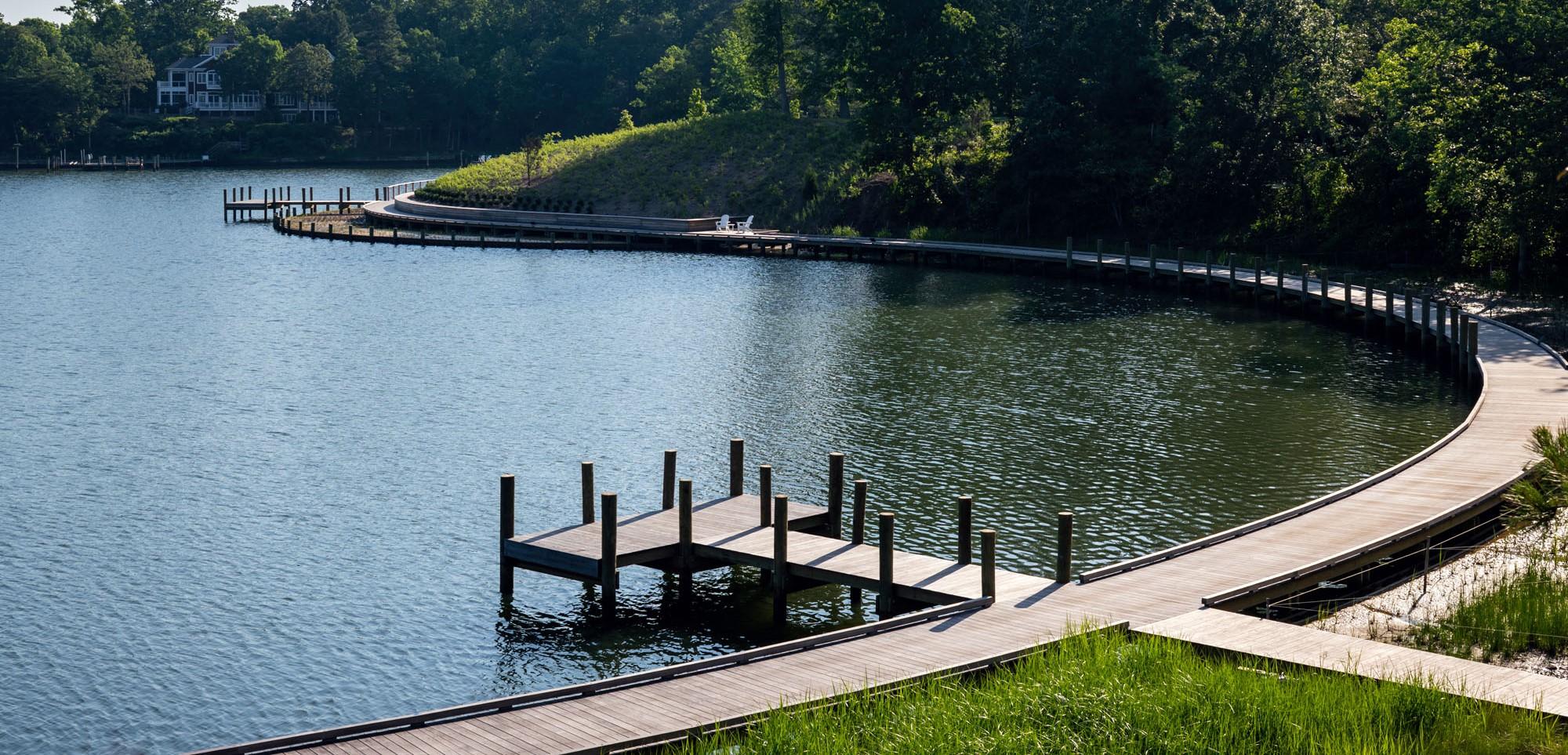The online edition of Metropolis magazine recently published a feature article I wrote on a landscape intervention at Virginia’s Tide’s Inn. It’s a luxury resort sited on a small creek that feeds into the Rappahannock River, which in turn flows to the Chesapeake Bay. It was a major shoreline restoration project that not only reduces stormwater runoff and cleans water entering the bay, but encourages natural life at water’s edge, and creates a 1,300 -linear-foot, curving wharf-walk for guests at the inn. A+A is pleased to re-post the feature today:
Where storm-driven trees and brush once tumbled down a 22-foot bluff into Carter’s Creek in Virginia’s Northern Neck, a living shoreline now reduces sediment pollution and introduces new life to the Chesapeake Bay.
It’s a cutting-edge landscape intervention that flowed from a collaboration among four forward-thinking entities: the Tides Inn luxury resort in Irvington, Virginia; Gluckman Tang Architects from New York; Waterstreet Studio out of Richmond, Virginia; and Bay Design Group from Urbanna, Virginia.
“All of us were on board with a restoration-ecology approach to reestablish a living shoreline,” says Eugene Ryang, principal at Waterstreet, specialists in landscape architecture and ecological design.
The standard solution would be to install a raised bulkhead wall with plantings behind it, but that would eliminate marine habitat at the tidal edge. “It works temporarily but doesn’t deal with the long term. These edges are critical for the health of the bay,” he says.
Waterstreet recommended a curvilinear wharf-walk with a sill, or structure, below to retain the living shoreline. The sill is composed of vinyl at the mean low-water height, plus stone breakwaters, then oyster shells. It creates an edge where sand and planted shoreline can take over.
Twice a day, high tides flood the sill and the newly planted zone. “The hope is that oysters, crabs, fish, snails, and birds will inhabit the sill,” he says. “It jumpstarts the project, and that edge condition is critical: crabs lay eggs there, oysters live there, and fish lay eggs there. It’s where all life occurs.”
The team brought in construction equipment by barge to soften the angle of the 22-foot slope, while respecting the Tides Inn’s cluster of resort buildings. “We understood the slope necessary for the historic structures up there, and still wanted to maximize the amount of shoreline that could survive,” says Carlin Tacey, Waterstreet’s project manager. “We’re slowing down the water flow, and trying to use a planted landscape to absorb nutrients that would end up in the bay.”
They intervened where invasive species like kudzu and English ivy had taken over above, then planted trees and plugged native grasses into sand to absorb excess nutrients from stormwater runoff. “We’re doing a ton of stormwater management upstream so we’re not dumping stormwater directly into the creek,” Ryang says. “The new landscape re-establishes the estuary edge which is slowly disappearing because of erosion on the landward side and rising tidal creek levels on the water side.”
Meanwhile, at the shoreline, crabs feed on algae, and each mature oyster cleans 50 gallons of water a day. Because Carter’s Creek feeds into the Rappahannock River, which in turn flows to the Chesapeake Bay, marine life from the creek can eventually reach the bay.
The entire watershed intervention is more than an exercise in landscape architecture, it’s a prototype for homeowners, environmentalists, and the upstream agricultural community. “The Friends of the Rappahannock group brings farmers down from along the Rappahannock River to demonstrate what they can do, and what should be done,” Ryang says.
To be sure, bulkhead walls remain in use at the Tides Inn marina, but the structural changes to the slope, the new plantings, the vinyl/stone/oyster shell sill, the 1,300-foot, curving wharf-walk, and an expanded beachfront set new standards for creating healthy shorelines on the Chesapeake Bay.
But it’s just a start. “It’s a small intervention, a micro-intervention— a blip in the overall bay,” he says. “Still, it might be the biggest.”
It fits Waterstreet’s environmental principles of “laying lightly on the land,” as well as its design ethos of form following function in a beautiful, sustainable, and regenerative way. “It’s not just an engineering project,” Ryang says. “You need something poetic that makes people act.”
He likes to say that his firm is not only designing with nature but is often designing nature itself.
What could be more poetic than that?
For more, go here.
[slideshow id=2478]


